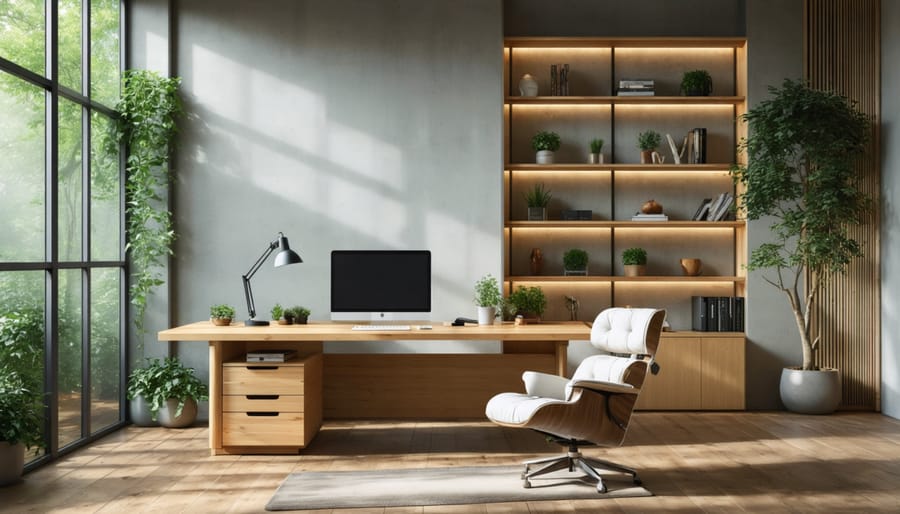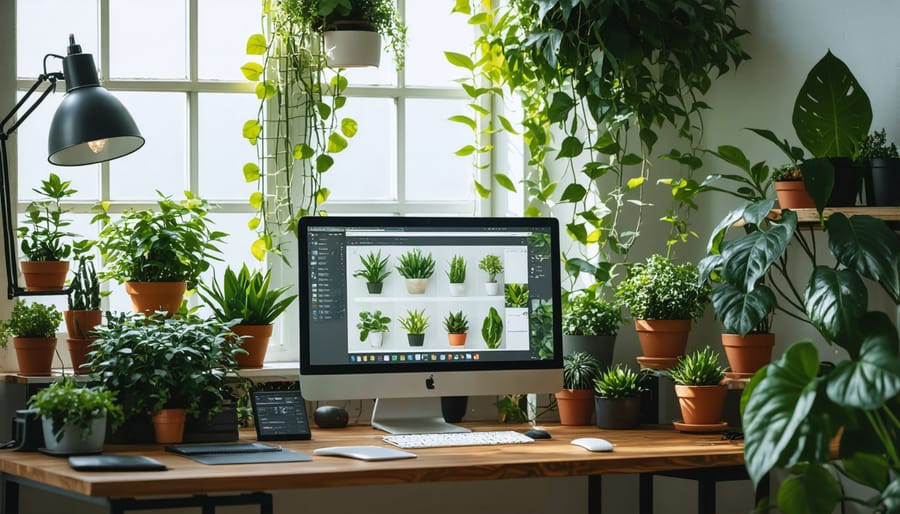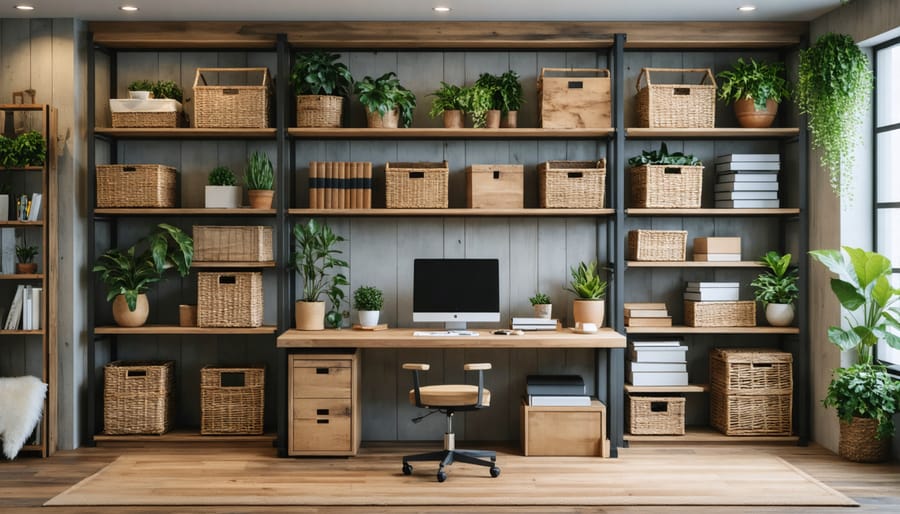Transform your home workspace into a sustainable sanctuary by blending modern design with organic elements. Natural materials, thoughtful lighting, and biophilic touches create a productive environment that nurtures both creativity and environmental consciousness. Today’s eco-conscious professionals demand more than just a desk and chair—they seek a harmonious balance between functionality and sustainable living. A modern organic home office delivers this perfect fusion, incorporating renewable materials, energy-efficient solutions, and nature-inspired design elements that promote wellness while minimizing environmental impact.
In this era of remote work, your home office should reflect both your professional aspirations and environmental values. Whether you’re retrofitting an existing space or designing from scratch, implementing organic principles doesn’t mean sacrificing modern aesthetics or technological necessities. From bamboo furniture to living walls, from natural light optimization to zero-VOC finishes, every element can contribute to a healthier, more sustainable workspace that inspires productivity and environmental stewardship.
Let’s explore how to create a home office that’s not just a workspace, but a testament to sustainable living and modern design sensibility.
Natural Materials That Define Modern Organic Style
Sustainable Wood and Bamboo Solutions
When it comes to creating a truly organic home office, sustainable wood and bamboo materials are your best allies. FSC-certified wood ensures your furniture comes from responsibly managed forests, making it an excellent choice for eco-conscious homeowners. Look for certification labels on desks, shelving units, and storage solutions to guarantee your purchase supports sustainable forestry practices.
Bamboo has emerged as a stellar alternative to traditional hardwoods, offering impressive durability while being one of the fastest-growing renewable resources. This versatile material works beautifully in modern office settings, whether as a sleek desk surface, floating shelves, or decorative wall panels. Its natural grain patterns and warm tones add organic texture while maintaining a contemporary feel.
Consider mixing both materials for a dynamic workspace. Try pairing an FSC-certified oak desk with bamboo accessories like file organizers, desk trays, or even chair mats. For a budget-friendly approach, look for secondhand solid wood furniture that you can refinish with non-toxic stains or oils.
Expert tip: When shopping for bamboo furniture, opt for items made with mature bamboo (at least 5-6 years old) and compressed using formaldehyde-free adhesives. This ensures maximum durability and maintains the air quality in your workspace. Remember, sustainable materials don’t just benefit the environment – they create a healthier, more inspiring place to work.

Eco-Friendly Textiles and Finishes
When selecting textiles and finishes for your organic home office, choosing eco-friendly materials isn’t just good for the planet – it creates a healthier workspace for you too. Natural fabrics like organic cotton, hemp, and linen are excellent choices for curtains, chair upholstery, and throw pillows. These materials are renewable, biodegradable, and free from harmful synthetic chemicals.
For your desk and storage furniture, look for pieces finished with natural oils, waxes, or water-based sealants. Traditional polyurethane finishes can off-gas harmful VOCs (volatile organic compounds), while natural alternatives like tung oil, beeswax, or zero-VOC sealants provide beautiful protection without the toxic fumes.
Consider cork for flooring or wall coverings – it’s naturally antimicrobial, sustainable, and adds wonderful texture to your space. Wool carpets and rugs are another excellent choice, offering durability and natural stain resistance without synthetic materials.
When selecting paint, opt for zero-VOC or natural mineral-based options. These eco-friendly alternatives come in beautiful modern colors and create a healthier indoor environment. For window treatments, bamboo shades or organic cotton panels provide natural light control while maintaining your commitment to sustainable materials.
Remember to look for certifications like GOTS (Global Organic Textile Standard) or OEKO-TEX when purchasing fabrics, ensuring your materials truly meet organic and eco-friendly standards.
Biophilic Design Elements
Living Plants and Natural Light
Bringing life into your organic home office starts with strategic placement of plants and maximizing natural light. Position your desk near a window to take advantage of daylight, which not only reduces energy consumption but also boosts productivity and mood. For optimal lighting, use sheer curtains or adjustable blinds to control glare while maintaining brightness throughout the day.
Choose plants that thrive in your specific lighting conditions. Low-light varieties like snake plants and ZZ plants are perfect for corners away from windows, while peace lilies and pothos can adapt to various light levels. Create a vertical garden using wall-mounted planters to save desk space, or opt for a statement plant like a fiddle leaf fig to add height and visual interest.
To maintain healthy plants while keeping your workspace organized, consider these practical tips:
– Use self-watering planters to reduce maintenance
– Group plants with similar water needs together
– Install floating shelves near windows for smaller plants
– Rotate plants quarterly to ensure even growth
– Choose air-purifying varieties like spider plants and rubber plants
Remember to balance the number of plants with your available space and maintenance capacity. Even a few well-placed plants can significantly impact air quality and create a more inviting atmosphere. For darker areas, consider LED grow lights that complement your office’s modern aesthetic while supporting plant health.

Natural Textures and Patterns
Natural textures and patterns play a pivotal role in creating a harmonious modern organic home office that feels both grounded and inspiring. Start by incorporating wood grain patterns through furniture pieces or wall panels, which add warmth and visual interest while maintaining a connection to nature. Consider using bamboo blinds or cork wall tiles to introduce subtle organic textures that don’t overwhelm the space.
Layer your office with natural fabrics like linen, cotton, or wool in earthy tones. A woven grass cloth wallpaper can create a stunning accent wall, while a jute rug adds texture underfoot without compromising the modern aesthetic. Look for furniture pieces with organic shapes and natural patterns, such as a desk with live edge details or chairs upholstered in botanical prints.
Don’t forget about smaller decor elements – consider adding woven baskets for storage, textured ceramic planters, or stone accessories that showcase nature’s inherent patterns. Mix different textures thoughtfully to create visual depth without cluttering the space. For instance, pair smooth concrete surfaces with rough-hewn wood, or combine sleek metal fixtures with textured fabric panels.
The key is to maintain balance – while natural textures add character, too many competing patterns can create visual chaos. Choose two or three dominant textures and complement them with simpler elements to create a cohesive, modern organic look that remains professional and functional.
Energy-Efficient Solutions
Smart Lighting Systems
Lighting plays a crucial role in creating a productive and comfortable home office environment. Modern sustainable lighting solutions offer both energy efficiency and smart functionality that can transform your workspace.
LED lighting stands out as the cornerstone of modern office illumination. These energy-efficient bulbs last up to 25 times longer than traditional ones and use about 75% less energy. Choose warm white LEDs (2700-3000K) for a cozy atmosphere that won’t strain your eyes during long work sessions.
Smart lighting systems take your office lighting to the next level. Consider installing programmable LED strips under shelving or behind your monitor for ambient lighting that reduces eye strain. Many systems now offer voice control through smart home assistants and smartphone apps, allowing you to adjust brightness and color temperature throughout the day.
Automated solutions like motion sensors and daylight harvesting systems can help optimize your lighting usage. Set up schedules that mirror natural light patterns – brighter, cooler light in the morning for focus, transitioning to warmer tones in the evening. Some systems even integrate with your calendar, automatically adjusting lighting for video calls or focus time.
Don’t forget task lighting! A good desk lamp with adjustable brightness and color temperature settings can provide targeted illumination when needed. Look for options with built-in USB ports to reduce cable clutter while keeping your devices charged.
Energy-Saving Equipment
Creating an energy-efficient home office doesn’t mean sacrificing performance or style. Start with your main workspace powerhouse – opt for ENERGY STAR certified laptops or desktop computers, which use up to 60% less electricity than standard models. Look for LED monitors with automatic brightness adjustment features to reduce eye strain and energy consumption simultaneously.
When it comes to lighting, invest in LED desk lamps with adjustable color temperatures and brightness levels. These smart lights can adapt to your daily routine and natural light conditions, using just a fraction of the energy traditional bulbs consume. Consider models with built-in occupancy sensors that automatically turn off when you step away.
Don’t overlook the smaller devices. Choose a multi-function printer that combines scanning, copying, and printing capabilities, and remember to enable its energy-saving mode. Smart power strips are essential for eliminating phantom energy draw – they automatically cut power to devices in standby mode, saving you money while protecting your equipment.
For climate control, a smart thermostat can optimize your office temperature throughout the day. Complement this with a small, energy-efficient fan or space heater with eco-modes for personalized comfort without overtaxing your home’s HVAC system.
Remember to regularly maintain your equipment and keep air vents clean for optimal performance. By choosing energy-efficient devices, you’re not just reducing your carbon footprint – you’re creating a more comfortable, cost-effective workspace that works as hard as you do.
Sustainable Storage and Organization
Minimalist Storage Solutions
In a modern organic home office, smart storage solutions are essential for maintaining both minimalism and sustainability. Start with wall-mounted floating shelves made from reclaimed wood or bamboo, which maximize vertical space while adding natural warmth to your workspace. These shelves can display both decorative items and frequently used supplies, keeping your desk clear and focused.
Consider modular storage systems that can grow with your needs. Stackable boxes crafted from sustainable materials like cork or recycled cardboard offer flexibility while maintaining an eco-friendly approach. For documents and files, opt for sleek filing cabinets made from FSC-certified wood or recycled metal, which blend seamlessly with modern aesthetic while supporting environmental consciousness.
Make use of hidden storage opportunities by selecting furniture pieces that serve multiple purposes. A window seat with built-in drawers provides both comfortable seating and extra storage space. Desktop organizers made from natural materials like bamboo or recycled glass help keep essential items within reach while maintaining a clean aesthetic.
Don’t overlook the power of vertical organization. Install pegboards made from sustainable materials to create customizable wall storage that can evolve with your needs. Use natural fiber baskets and organic cotton storage bags to keep smaller items organized while adding texture to your space. Remember, the key to minimalist storage is choosing quality pieces that are both functional and aesthetically pleasing, ensuring every item has its designated place.
Upcycled Organization Systems
Transform your home office into an organized haven using items you already have! By exploring creative upcycling ideas, you can create unique storage solutions that add character to your workspace while reducing waste.
Consider turning mason jars into stylish pen holders and paperclip containers by painting them in muted earth tones or leaving them naturally transparent. Old wooden crates can be mounted on walls as floating shelves, perfect for storing books, files, and decorative items. Wine boxes make excellent drawer organizers when fitted with small dividers, ideal for keeping office supplies neatly sorted.
Got some unused ceramic mugs? They’re perfect for corralling smaller items like thumb tacks and rubber bands. Transform wooden pallets into vertical file organizers by adding pockets made from recycled canvas or burlap. Empty tin cans, when cleaned and decorated with twine or sustainable paper, become charming holders for art supplies or charging stations for electronics.
For desk organization, repurpose vintage silverware trays as drawer dividers, or use old picture frames to create memo boards by adding twine or recycled wire mesh. Even cardboard boxes can be transformed into beautiful storage containers when covered with natural fabrics or sustainable papers.
Remember to maintain a cohesive look by using similar colors or materials across your upcycled pieces, ensuring your organizational system enhances rather than clutters your modern organic office space.

Creating a modern organic home office doesn’t have to be overwhelming or expensive. By focusing on sustainable materials, incorporating natural elements, and maintaining a clean, minimalist aesthetic, you can design a workspace that’s both environmentally conscious and professionally inspiring. Remember to start with the basics: choose eco-friendly furniture, maximize natural light, and include plenty of living plants to purify the air and boost your mood.
The key to success lies in thoughtful planning and gradual implementation. Start with one area at a time, perhaps beginning with your desk setup or lighting solutions, and build from there. Don’t feel pressured to transform your entire space overnight – sustainable design is, after all, about long-term thinking.
Consider these final tips as you move forward: regularly assess your space’s functionality, rotate your plants seasonally for optimal growth, and maintain a clutter-free environment to maximize productivity. Update your organic elements as needed, and don’t be afraid to mix different natural materials and textures to create visual interest.
Most importantly, make the space your own. While following design principles is helpful, your home office should reflect your personal style and work habits. With mindful choices and regular maintenance, your modern organic home office will become a sustainable sanctuary that supports both your professional goals and environmental values.
